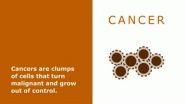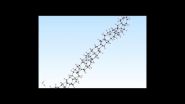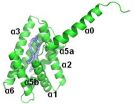(Press-News.org) Biochemists working at the University of California, San Diego, have developed a program that predicts the placement of chemical marks that control the activity of genes based on sequences of DNA. They describe their analysis and report results from its application to human embryonic cells in a paper published in Nature Methods online September 21.
"All of our cells have the same blueprint, the same DNA, although they serve separate functions," said John Whitaker, lead author of the report. "Skin cells protect, nerve cells send signals, and these differences emerge because different subsets of genes are active or silent within particular kinds of cells."
These patterns of activity are controlled by modifications of the DNA that do not alter its sequence—chemical tags that influence which genes are read and which are skipped within a particular cell.
By comparing sequences with and without epigenomic modification, the researchers identified DNA patterns associated with the changes. They call this novel analysis pipeline Epigram and have made both the program and the DNA motifs they identified openly available to other scientists.
"The interplay between genetic and epigenomic regulation has only begun to be deciphered," said Wei Wang, professor of chemistry and biochemistry who directed the work. "This study revealed that there are specific DNA sequences that are recognized by DNA-binding proteins," which specify exactly where other enzymes place epigenomic marks.
The epigenome guides the development of complex organisms from single fertilized eggs. The researchers analyzed epigenomic patterns in human embryonic stem cells and four cell lineages derived from them to catalogue genetic elements that shape the epigenome during development.
Damage to the epigenome not only disrupts development, but can happen at any point in our lives and sometimes leads to illness. Identification of the DNA sequences that guide the placement of epigenomic could guide experimental analysis, the authors say. By editing DNA sequences that control epigenomic modifications, scientists could probe their functions and perhaps in the future mend epigenomic mistakes that cause harm. —Susan Brown
INFORMATION:
Additional author Zhao Chen is a postdoctoral researcher working with Wang. John Whitaker, a former postdoctoral researcher in the group now works for Janssen Pharmaceutical Companies of Johnson & Johnson. A grant from the National Institute of Environmental Health Sciences to the San Diego Epigenome Center partially supported this work.
Program predicts placement of chemical tags that control gene activity
Novel analysis predicts the placement of epigenomic marks from DNA motifs
2014-09-21
ELSE PRESS RELEASES FROM THIS DATE:
Battling superbugs
2014-09-21
CAMBRIDGE, MA -- In recent years, new strains of bacteria have emerged that resist even the most powerful antibiotics. Each year, these superbugs, including drug-resistant forms of tuberculosis and staphylococcus, infect more than 2 million people nationwide, and kill at least 23,000. Despite the urgent need for new treatments, scientists have discovered very few new classes of antibiotics in the past decade.
MIT engineers have now turned a powerful new weapon on these superbugs. Using a gene-editing system that can disable any target gene, they have shown that they can ...
Immune system of newborn babies is stronger than previously thought
2014-09-21
Contrary to what was previously thought, newborn immune T cells may have the ability to trigger an inflammatory response to bacteria, according to a new study led by King's College London. Although their immune system works very differently to that of adults, babies may still be able to mount a strong immune defense, finds the study published in the journal Nature Medicine.
Our immune system is made up of several different types of immune cells, including neutrophils which play an important role in the frontline defense against infection, and lymphocytes: B cells which ...
Uncovering the forbidden side of molecules
2014-09-21
Researchers at the University of Basel in Switzerland have succeeded in observing the "forbidden" infrared spectrum of a charged molecule for the first time. These extremely weak spectra offer perspectives for extremely precise measurements of molecular properties and may also contribute to the development of molecular clocks and quantum technology. The results were published in the scientific journal Nature Physics.
Spectroscopy, the study of the interaction between matter and light, is probably the most important method for investigating the properties of molecules. ...
Magnetic fields make the excitons go 'round
2014-09-21
CAMBRIDGE, Mass-- A major limitation in the performance of solar cells happens within the photovoltaic material itself: When photons strike the molecules of a solar cell, they transfer their energy, producing quasi-particles called excitons — an energized state of molecules. That energized state can hop from one molecule to the next until it's transferred to electrons in a wire, which can light up a bulb or turn a motor.
But as the excitons hop through the material, they are prone to getting stuck in minuscule defects, or traps — causing them to release their energy ...
Engineered proteins stick like glue -- even in water
2014-09-21
CAMBRIDGE, MA -- Shellfish such as mussels and barnacles secrete very sticky proteins that help them cling to rocks or ship hulls, even underwater. Inspired by these natural adhesives, a team of MIT engineers has designed new materials that could be used to repair ships or help heal wounds and surgical incisions.
To create their new waterproof adhesives, the MIT researchers engineered bacteria to produce a hybrid material that incorporates naturally sticky mussel proteins as well as a bacterial protein found in biofilms — slimy layers formed by bacteria growing on a surface. ...
Cancer cells adapt energy needs to spread illness to other organs
2014-09-21
Want to understand why cancer cells metastasize? Think of Sparta.
Ancient Greek warriors were fed a special diet that better prepared them for the demands of battle on distant fields. Cancer cells that metastasize may do the same thing according to a new study revealing previously unknown differences between cancer cells that continue to grow at the original tumor site, and those that travel to other organs.
Given that a cancer cell's unyielding ability to metastasize is the primary cause of cancer-related death, understanding how they successfully migrate can be lifesaving.
Scientists ...
Stanford researchers create 'evolved' protein that may stop cancer from spreading
2014-09-21
VIDEO:
Early but promising tests in lab mice suggest that a bioengineered 'decoy' protein, administered intravenously, can halt the spread of cancer from the original tumor site. Years of subsequent tests...
Click here for more information.
A team of Stanford researchers has developed a protein therapy that disrupts the process that causes cancer cells to break away from original tumor sites, travel through the blood stream and start aggressive new growths elsewhere in the body.
This ...
Smallest possible diamonds form ultra-thin nanothreads
2014-09-21
VIDEO:
For the first time, scientists have discovered how to produce ultra-thin 'diamond nanothreads' that promise extraordinary properties, including strength and stiffness greater than that of today's strongest nanotubes and polymers....
Click here for more information.
For the first time, scientists have discovered how to produce ultra-thin "diamond nanothreads" that promise extraordinary properties, including strength and stiffness greater than that of today's strongest ...
New cancer drug target involving lipid chemical messengers
2014-09-19
PHILADELPHIA — More than half of human cancers have abnormally upregulated chemical signals related to lipid metabolism, yet how these signals are controlled during tumor formation is not fully understood.
Youhai Chen, PhD, MD, and Svetlana Fayngerts, PhD, both researchers in the department of Pathology and Laboratory Medicine at the Perelman School of Medicine, University of Pennsylvania, and colleagues report that TIPE3, a newly described oncogenic protein, promotes cancer by targeting these pathways.
Lipid second messengers play cardinal roles in relaying and amplifying ...
Melanoma risk found to have genetic determinant
2014-09-19
(Lebanon, NH 9/18/14)— A leading Dartmouth researcher, working with The Melanoma Genetics Consortium, GenoMEL, an international research consortium, co-authored a paper published today in the Journal of the National Cancer Institute that proves longer telomeres increase the risk of melanoma.
"For the first time, we have established that the genes controlling the length of these telomeres play a part in the risk of developing melanoma," said lead author of the study Mark Iles, PhD, School of Medicine at the University of Leeds (UK).
Telomeres are a part of the genome ...
LAST 30 PRESS RELEASES:
People with rare longevity mutation may also be protected from cardiovascular disease
Mobile device location data is already used by private companies, so why not for studying human-wildlife interactions, scientists ask
Test reveals mice think like babies
From disorder to order: flocking birds and “spinning” particles
Cardiovascular risk associated with social determinants of health at individual and area levels
Experimental NIH malaria monoclonal antibody protective in Malian children
Energy trades could help resolve Nile conflict
Homelessness a major issue for many patients in the emergency department
Undocumented Latinx patients got COVID-19 vaccine at same rate as US citizens
ETRI develops an automated benchmark for labguage-based task planners
Revolutionizing memory technology: multiferroic nanodots for low-power magnetic storage
Researchers propose groundbreaking framework for future network systems
New favorite—smart electric wheel drive tractor: realizes efficient drive with ingenious structure and intelligent control
Using stem cell-derived heart muscle cells to advance heart regenerative therapy
Damon Runyon Cancer Research Foundation awards Quantitative Biology Fellowships to four cutting-edge scientists
Climb stairs to live longer
Scientists capture X-rays from upward positive lightning
AMS Science Preview: Hawaiian climates; chronic pain; lightning-caused wildfires
Researchers advance detection of gravitational waves to study collisions of neutron stars and black holes
Automated machine learning robot unlocks new potential for genetics research
University of Toronto scientists appointed as GSK chairs will advance drug delivery research and vaccine education tools for healthcare professionals
Air pollution and depression linked with heart disease deaths in middle-aged adults
More efficient molecular motor widens potential applications
Robotic nerve ‘cuffs’ could help treat a range of neurological conditions
Researchers identify targets in the brain to modulate heart rate and treat depressive disorders
Findings of large-scale study on 572 Asian families supports gene-directed management of BRCA1 and BRCA2 gene carriers in Singapore
Many children with symptoms of brain injuries and concussions are missing out on vital checks, national US study finds
Genetic hope in fight against devastating wheat disease
Mutualism, from biology to organic chemistry?
POSTECH Professor Yong-Young Noh resolves two decades of oxide semiconductor challenges, which Is published in prestigious journal Nature
[Press-News.org] Program predicts placement of chemical tags that control gene activityNovel analysis predicts the placement of epigenomic marks from DNA motifs




